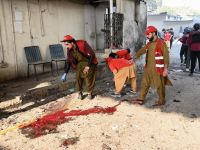“These photos must be from the late 1800s or early 1900s,” you think, glancing at the black-and-white pictures of men, women and children from Lebanon’s Druze community, of cedar trees, thistles, a fountain.
They appear frozen in time, with the characteristic edges and aberrations of old, analogue, large-format photography. But they weren’t taken last century. The oldest were taken last year.
For his project “Les Maitres Du Secret” (The Masters of the Secret), up now as part of the Beiteddine Art Festival, Jack Dabaghian has chosen an early photographic technique.
The France-based Lebanese-Armenian photographer said the idea of focusing on the Druze first came to him during Lebanon’s 1975-90 Civil War, when he was covering the Chouf Mountain War for Reuters.
“When Walid Joumblatt declared the end of the [Mountain] War, they had a big festival to celebrate the event - and in Beiteddine, funnily enough,” he recalls. “That’s where I had the luck of having all the sheikhs, all of them carrying weapons, with the magic hour of the day - and I was like, ‘Wow, these guys really deserve to be properly photographed.’”
Four years ago, after more than two decades of photojournalism and commercial photography, Dabaghian began to embark on this project. Thanks to contacts including Nora Joumblatt and Sid Rouis, the outgoing French Institute head in Deir al-Qamar, the community’s doors gradually opened.
{"preview_thumbnail":"https://cdn.flowplayer.com/6684a05f-6468-4ecd-87d5-a748773282a3/i/v-i-9…","video_id":"92bf8968-e340-474b-a358-0b1b1f763c9a","player_id":"8ca46225-42a2-4245-9c20-7850ae937431","provider":"flowplayer","video":"UN Seals Agreement With Houthis to Resume Food Aid in Yemen"}
At that time he also began researching the history of the Druze and photography in the Middle East.
“I was extremely surprised not to find many [old] photographs” of the Druze, he said, citing institutions with historic archives in Lebanon such as the American University of Beirut and the Sursock Museum, and others abroad like the U.S. Library of Congress.
(Visitors to the Sursock can spy a few images in a projection of postcards in the Fouad Debbas Collection room right now.)
Dabaghian’s decision to use the 19th-century wet collodion process is an interesting one, not least for its disorienting temporal effect.
His project recalls the pioneering role of Armenian photographers in establishing a local practice in the Middle East - recently cited in Issam Nassar’s essay in “Photographs 1842-1896: An Early Album of the World,” which accompanied an exhibition of historic images at the Louvre Abu Dhabi earlier this year.
It could raise less noble parallels, though, when seen in the context of some of Dabaghian’s previous commercial work, such as portraits in Ethiopia and the Republic of Congo, and the Orientalist use of photography to appropriate the East for the West.
Dabaghian says his approach is based on the long, slow and hard-earned process of gaining the trust and respect of the Druze community, and has made efforts to bring them along with him on his journey.
“Some of them thought I was here because of my professional past, trying to find the sheikhs I had photographed back during the war,” he says. “When they said yes initially, they still could not trust [me],” he adds.
“Had I been like the selfish photographer, [just] doing my own thing, I would have reached a certain entry level. When they saw I was actually committed, paying attention to their traditions, paying my respects at funerals etc, a door started opening up more and more.”
Dabaghian also recognizes the role of Sheikh Sami Abil-Mona, the current head of the Irfan Establishment, and Sheikh Ali Zeineddine, the Druze body’s former head, in having the community accept him.
He describes Abil-Mona as a religious leader “who knows that the Druze community is in danger if they don’t open up. They are stuck in between keeping the traditions, their religion, their secrets, but at the same time, they know they have to open up because globalization - through the phones that we use today, through social networks - is going to push them into a direction they may not control. So he understood and gave me all his backing and support, political support.”
Dabaghian’s choice to use wet collodion did not make things simple. He had to look for expert advice, a large-format camera (he had one custom-made by an Italian company) and hard-to-get supplies.
The camera uses glass or aluminum plates that Dabaghian must prepare on location. His subject must already be in place when he starts this process, with a single photo taking 45 minutes.
“From the second I start pouring the chemicals on the plate to the minute I wash the plate, everything needs to stay wet,” Dabaghian explains, “so that means wherever I go on the ground, I’m carrying a lab with me - a makeshift lab that I created from two camping tables that I put one on top of the other, upside down.”
“My car is filled with equipment,” he adds, “from the boot to the rear seats.”
He has to store and transport the mixed chemicals in a cooler, because “it’s highly explosive - boiling temperatures start around 30 degrees centigrade.”
If working with glass, he has to clean the surface and seal it with egg white, then pour the mixed collodion evenly onto the plate. When it starts to dry slightly, he puts it into a silver nitrate tank to make it sensitive to light, then loads it in the film holder and places it in the camera.
After taking the photo - and imploring his subjects to stay entirely still, as the long exposure times mean the slightest movements can result in blur - he must immediately finish the developing process in his makeshift lab, put the plate into the fixer for several minutes then wash it. “Every plate needs to be washed, in running water, for 20 minutes, minimum,” he says, before it can be left to dry.
“What’s really [annoying] is when I reach an area where there’s no running water. That means I have to carry [many full] jerry cans,” he adds, or send someone to collect more if it runs out.
Dabaghian then transports his fragile production to France to have the plates scanned, before choosing paper and ink for the prints.
“I tell the people who are involved in this whole adventure that, had I known I had to go through that much hassle from before starting, I probably would have not done it,” Dabaghian says, “but the biggest reward is when you’re exhausted and can’t think clearly anymore and you put all these prints on the ground, pull back and have a look, [and think], ‘Wow, did I do this? This is impossible.’”
“Les Maitres Du Secret” is one of two photo exhibitions showing as part of the Beiteddine Art Festival until Aug. 10. It is open during Beiteddine Palace visiting hours with an entry fee. If the door to the exhibition is closed, be sure to ask to enter. For more, visit beiteddine.org.
This article has been adapted from its original source.








